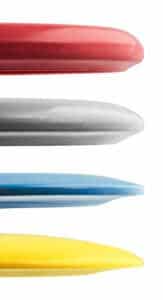Finding the Right Disc Stability for Your Needs

Choosing a disc stability of the right type and measurement is a crucial skill for disc golfers. Knowing the impact of disc stability on disc flight and how to measure it can help improve your game as a disc golfer.
What is Disc Stability
Disc stability is a rating system used to classify the flight patterns of disc golf discs. Disc stability refers to how a disc responds to its environment during flight, particularly with regard to turning, fading, and gliding. Disc stability can be broken down into four distinct segments: ultra-stable, overstable, stable, and understable. An ultra-stable disc generally exhibits little to no turn and is excellent for smooth flights and long straight throws. Overstable discs tend to turn more and have a strong fade at the end of the flight. Stable discs have a moderate turn for both backhand and forehand throws making it easier to control. Lastly, understable discs are designed to turn left and right during the flight and are ideal for novice players.
Evaluating Disc Stability Needs
The disc stability you choose will depend on the type of flight you are looking for and your skill level as a golfer. Beginners should start out with discs that are understable, as they are easier to control and learn with. Intermediate players may benefit from a combination of discs, such as an ultra-stable and overstable disc, to better control their throws. Advanced and professional players may want to consider combining an overstable and understable disc for more precision and accuracy in their throws.
Choosing Disc Stability Type
When choosing the type of disc stability, think about the type of throws you want to make and your skill level. An ultra-stable disc may be the best choice for experienced players that are aiming for a long, straight shot, while an overstable disc will suit players that have more control and need shots that fade to the right or left. For novice players, an understable disc will provide greater control and a gentler fade at the end of the flight.
Factors Affecting Disc Stability
Your disc stability will also be affected by factors such as the weather, wind, and the disc’s stability rating. For example, if the weather is calm and windless, you may opt for a more stable disc that offers straight-flying shots. If you are playing in windy conditions, you will likely want to choose a more overstable disc to keep your flight on track when the wind pushes it out of line. Similarly, discs with a higher stability rating will offer more stability and control, while discs with a lower stability rating will be more susceptible to the elements.
Measuring Disc Stability
On the surface, visually inspecting a disc’s stability can be done. An experienced discer can determine which kind of stability a disc will deliver just by looking at it. However, the most accurate way to measure disc stability is with a stability tester. This tool measures the stability of a disc, which can be recorded and referenced for future use.
Ensuring Disc Stability Results
Once you have determined the appropriate disc stability for your needs, it is important to ensure that your chosen discs are up to the task. Keeping your discs in good condition is essential for keeping consistent performance. Discs that are worn or warped will change their flight path, so make sure your discs are free of any defects before you head out to the course.
Knowing the different types of disc stability and the factors that affect them can help you make more informed choices when selecting discs for your game. With the right information and tools, you can ensure that you find the right disc stability for your needs.
Recommended2 recommendationsPublished in Discs, Gear, Learn the Game











Know the plastic… Be the plastic
Straight up!